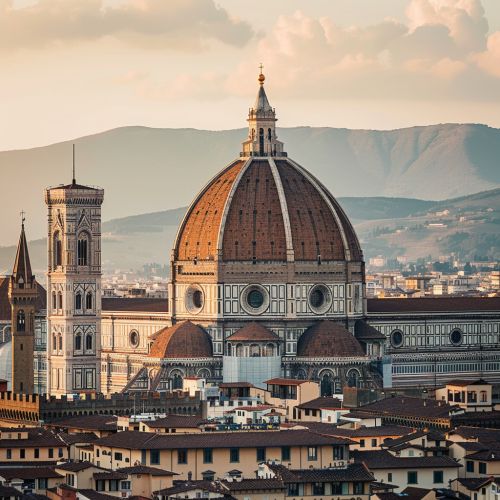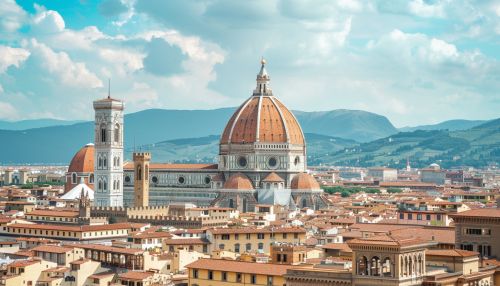History of Florence
Early History
Florence, known as Firenze in Italian, has a rich and complex history that dates back to its founding by the Romans in 59 BCE. The city was initially established as a military colony called Florentia, situated at the confluence of the Arno and Mugnone rivers. The strategic location facilitated trade and military movements, contributing to its early growth and prosperity.
Florentia was laid out in the typical Roman grid pattern, with a central forum, temples, and public baths. The remains of these structures can still be seen today, providing a glimpse into the city's ancient past. The Roman influence extended beyond architecture; it also shaped the city's social and political structures.
Medieval Florence
Rise of the Commune
The fall of the Western Roman Empire in the 5th century CE marked the beginning of a turbulent period for Florence. The city was invaded by various barbarian tribes, including the Ostrogoths and Lombards. Despite these challenges, Florence managed to retain its significance as a regional center.
By the 11th century, Florence had evolved into a self-governing commune, a city-state with its own political and economic systems. The Florentine Republic was established, governed by elected officials known as consuls. This period saw the rise of powerful merchant families who played a crucial role in the city's governance and economy.
Economic Prosperity
Florence's economy flourished during the medieval period, largely due to its thriving textile industry. The city became renowned for its high-quality woolen cloth, which was exported across Europe. The Arte della Lana, the wool guild, was one of the most influential organizations in Florence, controlling much of the city's economic activities.
The banking sector also emerged as a significant force, with families like the Medici establishing financial institutions that would later dominate European banking. The Medici Bank, founded in 1397, became one of the most powerful banks in Europe, facilitating international trade and finance.
Renaissance Florence
Cultural Renaissance
The 15th century marked the beginning of the Italian Renaissance, a period of unprecedented cultural and intellectual growth. Florence was at the heart of this movement, attracting artists, scholars, and thinkers from across Europe. The city's wealth and patronage system enabled the flourishing of arts and sciences.
Prominent figures such as Leonardo da Vinci, Michelangelo, and Dante Alighieri were either born in Florence or spent significant time there. The Medici family, particularly Lorenzo de' Medici, played a crucial role in supporting these artists and fostering an environment conducive to creativity and innovation.
Architectural Marvels
Florence's architectural landscape was transformed during the Renaissance. The construction of the Florence Cathedral, also known as the Duomo, began in 1296 and was completed in 1436 with the addition of the iconic dome designed by Filippo Brunelleschi. This structure remains one of the most significant architectural achievements of the period.
Other notable buildings include the Palazzo Vecchio, the Uffizi Gallery, and the Ponte Vecchio. These structures not only served practical purposes but also symbolized the city's wealth and artistic prowess.


Political Turmoil
Medici Rule
The Medici family's influence extended beyond economics and culture; they also played a pivotal role in Florence's political landscape. Cosimo de' Medici, also known as Cosimo the Elder, effectively controlled the city from behind the scenes, using his wealth and influence to manipulate political outcomes.
The Medici's rule was not without opposition. Rival families and political factions often challenged their authority, leading to periods of instability. Despite this, the Medici managed to maintain control for much of the 15th and 16th centuries, with members of the family even becoming Popes and Dukes.
Republic and Duchy
Florence experienced several shifts in governance between the 15th and 16th centuries. The city oscillated between republican and ducal rule, reflecting the broader political dynamics of Italy during this period. In 1494, the Medici were expelled, and Florence became a republic once again. However, this was short-lived, as the Medici returned to power in 1512.
In 1532, Florence was officially transformed into a duchy, with Alessandro de' Medici becoming its first Duke. This marked the end of the Florentine Republic and the beginning of a new era of centralized rule.
Modern Era
Unification of Italy
The 19th century brought significant changes to Florence, as it became a focal point in the movement for the unification of Italy. The city played a crucial role in the Risorgimento, the political and social process that led to the consolidation of different states of the Italian Peninsula into the single state of Italy.
In 1865, Florence was designated as the capital of the newly unified Italy, a status it held until 1871 when Rome became the capital. This period saw extensive urban development, including the demolition of the medieval city walls and the construction of new boulevards and public buildings.
20th Century and Beyond
Florence faced numerous challenges in the 20th century, including the devastation of World War II. The city was occupied by German forces and suffered significant damage during the war. The historic Ponte Vecchio was the only bridge across the Arno that was not destroyed by retreating German troops.
Post-war Florence underwent extensive reconstruction and modernization. The city continued to be a major cultural and academic center, attracting tourists, scholars, and artists from around the world. The 1966 flood of the Arno River caused severe damage to the city's art and architecture, but it also led to international efforts to restore and preserve Florence's cultural heritage.
Cultural Significance
Art and Literature
Florence's contribution to art and literature is immeasurable. The city is home to numerous museums, galleries, and libraries that house some of the world's most important works of art and literature. The Uffizi Gallery and the Accademia Gallery are renowned for their collections of Renaissance masterpieces.
Florence was also a center of literary activity. Dante Alighieri, one of the most important poets of the Middle Ages, wrote his seminal work, the Divine Comedy, in the Tuscan dialect, which later became the basis for the Italian language. Other notable literary figures include Petrarch and Boccaccio.
Education and Science
The city has a long tradition of education and scientific inquiry. The University of Florence, founded in 1321, is one of the oldest universities in Italy and has produced numerous scholars and scientists. The Accademia della Crusca, established in 1583, is the leading institution for the study and preservation of the Italian language.
Florence was also a hub for scientific innovation during the Renaissance. The Galileo Museum, dedicated to the famous astronomer and physicist Galileo Galilei, showcases the city's contributions to science and technology.
